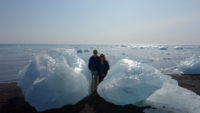 Diamonds, so the song proclaims, are a girl’s best friend. That doesn’t hold true for Meredith, whose love of European travel gives her an energy and endurance that can astonish at times. She often leaves her marathon-running husband in the tired dust. Meredith does come around to diamonds, though, when it is a sight to go see.
Diamonds, so the song proclaims, are a girl’s best friend. That doesn’t hold true for Meredith, whose love of European travel gives her an energy and endurance that can astonish at times. She often leaves her marathon-running husband in the tired dust. Meredith does come around to diamonds, though, when it is a sight to go see.
We started the day needing to get to the area around the town of Vik, and I was racing against the weather clock this time. Vik was supposed to start to get rain around 1:00, and I wanted to do some touring there before the heavier rains came along. Still, I had to make one stop – Diamond Beach, which is the beach next to the Jokulsarlon glacier lagoon. The lagoon empties out along a short and fast river that dumps into the Atlantic Ocean. When icebergs get small enough, they float down the river and out to sea, except for some which get stranded on Diamond Beach.
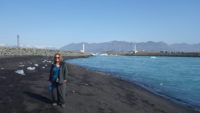 We had looked over at the beach the night before and hadn’t seen much ice. Still, it was on the way, and I had heard good things about it, so I stopped by. There was ice all over the beach. I don’t know if the tide had gone out and stranded more ice, or what had happened, but there were icebergs all over, from the size of my fist to the size of large boulders. Most were glinting in the sun because they were covered with meltwater, and they really stood out because the beach is a black sand beach. It was beautiful. We strolled around the place for about half an hour before getting back on the road.
We had looked over at the beach the night before and hadn’t seen much ice. Still, it was on the way, and I had heard good things about it, so I stopped by. There was ice all over the beach. I don’t know if the tide had gone out and stranded more ice, or what had happened, but there were icebergs all over, from the size of my fist to the size of large boulders. Most were glinting in the sun because they were covered with meltwater, and they really stood out because the beach is a black sand beach. It was beautiful. We strolled around the place for about half an hour before getting back on the road.
 The road to Vik got us along long plains of flat space where the glacier used to be a hundred years ago, but then changed into one of the largest lava fields in the world. There were cone-shaped mounds everywhere, which I assume was a result of lava meeting up with water. As we got close to Vik, we went back to mountains, with Iceland’s second biggest glacier, Eyjafjallajokul, sitting on top (and oozing down the mountains).
The road to Vik got us along long plains of flat space where the glacier used to be a hundred years ago, but then changed into one of the largest lava fields in the world. There were cone-shaped mounds everywhere, which I assume was a result of lava meeting up with water. As we got close to Vik, we went back to mountains, with Iceland’s second biggest glacier, Eyjafjallajokul, sitting on top (and oozing down the mountains).
We drove on through Vik, and I turned down the road to Reynisfjara, another black sand beach. My brother had been here and loved it, and it sounded cool. We grabbed a quick bite to eat at the cafe (now being cautious to eat when we can!), and then went to explore the beach in a misting rain.
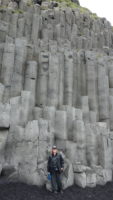 It is a dramatic place. The beach is mostly made up of very small black pebbles, although it does have some sand near the waterline. It is also dramatic in the numerous warning signs telling you not to go in the water and not to go near the water and not to turn your back on the water. Iceland has a phenomenon called “sneaker waves,” in which every now and then, a wave much much bigger than the other normal waves will sweep in on people and carry them off. Sadly, two people have died because of them in the last fifteen years. Meredith and I noted where the maximum wet sand line was, and then we gave that a healthy buffer.
It is a dramatic place. The beach is mostly made up of very small black pebbles, although it does have some sand near the waterline. It is also dramatic in the numerous warning signs telling you not to go in the water and not to go near the water and not to turn your back on the water. Iceland has a phenomenon called “sneaker waves,” in which every now and then, a wave much much bigger than the other normal waves will sweep in on people and carry them off. Sadly, two people have died because of them in the last fifteen years. Meredith and I noted where the maximum wet sand line was, and then we gave that a healthy buffer.
The beach is walled in by a cliff which is made of twisted columns of basalt (cooled lava that looks like pillars), and it also has some sea stacks out from shore. Throw in several sea-eroded caves in the cliff, and you have a pretty magical place. With the misting rain, it kind of added a somber feel to the place, but didn’t get us wet through our coats and hats.
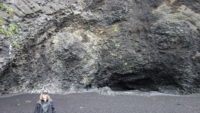 Since it was about 3:00 and we could check in, we drove down the road a bit and found our hotel. We tossed our bags in our room and headed out again, this time to Skogar, home of the Skogafoss waterfall, one of Iceland’s most visited. We went to the Skogar Museum. It is an interesting little museum in that it is an outdoor folk village of six buildings from the late 1800s, and an indoor museum of transportation and technology. We like folk museums and hadn’t been to one in Iceland yet, and it was starting to rain a little harder, so a museum seemed like a good idea.
Since it was about 3:00 and we could check in, we drove down the road a bit and found our hotel. We tossed our bags in our room and headed out again, this time to Skogar, home of the Skogafoss waterfall, one of Iceland’s most visited. We went to the Skogar Museum. It is an interesting little museum in that it is an outdoor folk village of six buildings from the late 1800s, and an indoor museum of transportation and technology. We like folk museums and hadn’t been to one in Iceland yet, and it was starting to rain a little harder, so a museum seemed like a good idea.
The folk museum had several turf-roofed houses and sheds, some of which were very nice inside. Wood was at a premium in 1880 Iceland (and probably still is), so many of the formal rooms of the houses on display were made from driftwood, or, in one case, wood salvaged from a shipwreck. The tiny one-room schoolhouse on the grounds was in use near here until 1968 (the ring road, Route 1, wasn’t finished in the southeast part of Iceland until 1972). The small church was a reconstruction on the outside, but the interior is almost all original and was pretty – carved wood that was brightly painted blue.
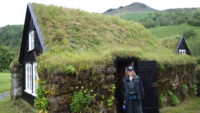
As the rain started to pick up, we moved inside to the transportation museum. There was a good section on the founding of Iceland’s postal system, which used to be by private contractors who had to pay for everything (food, horses, etc.) themselves. There were only four postal district sections originally – north, south, east, and west, and each section could initially only hire one man. This was expanded to two men in the south in the 1880s. Postmen had to carry horns with them to try to summon help should they get in trouble in a river or some such, and three postmen on the southern route died on duty. It sounded like an insanely difficult job.
Much of the rest of the museum was dedicated to transportation that moved well in snow (like half-tracked or fully tracked vehicles), or to machines used to make roads. Both of these made perfect sense for an area that had no roads to speak of until around 1900. The final section of the museum showcased rescue equipment and vehicles, which also fit for the area.
After the museum, we went back to Vik to have a good supper to make sure we didn’t miss an open restaurant. I also wanted to go to the Lava Show, where they mess around with molten lava, but the shows were all sold out. Still, we did get a good and hot supper, which we don’t take for granted in Iceland now.
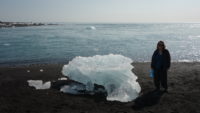 We made an early evening of it because of the rain, but I suspect Meredith would rather be rained on in Iceland while touring sights than be rained on back home schlepping papers from her classroom to the car. She needs the energy boost from the one to keep up the other for nine months each year.
We made an early evening of it because of the rain, but I suspect Meredith would rather be rained on in Iceland while touring sights than be rained on back home schlepping papers from her classroom to the car. She needs the energy boost from the one to keep up the other for nine months each year.